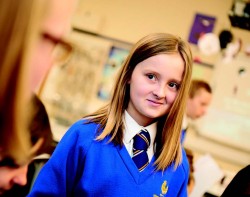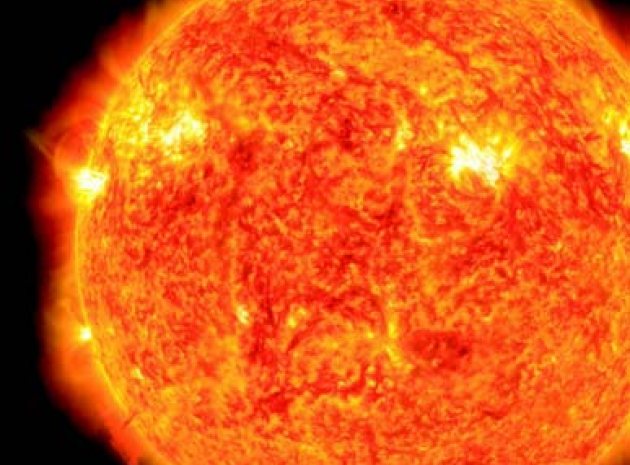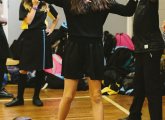Today you will…
• Learn about our sun
• Make a device to view the sun safely
• Determine the speed of light
“Who enjoys astronomy?” I ask my year 11s. We discuss the amazing things you can see in the sky: the constellations, the lunar surface, even the Orion Nebula. Then I comment that I most enjoy stargazing in the daytime. This attracts an interesting response. Most students challenge me and give a host of sensible reasons about ambient light and how dark it needs to be to see the stars properly. One enthusiastic student comments that in the darkest desert you can see the whole milky-way but in London you can’t see stars at all just because of street lights. This is very true, but in the daytime we can begin to appreciate the wonders of our nearest star, our spectacular sun. Through the activities outlined here, pupils will learn that our sun is a star that has constant and intense activity taking place on its surface. They will learn about the aurora borealis and what it tells us about activity on the sun and coronal mass ejections. Various methods of investigating solar activity during the daytime are possible and students can make a device to safely view the sun. They will also be able to explain the implications of solar storms on our telecommunications and electrical infrastructure. They will investigate electromagnetic radiation and determine for themselves the speed of light (throughout the activities you should stress the danger of looking at the sun with the naked eye, which can cause permanent blindness).
Starter activity
Investigating sunspots
To most students the sun is little more than a bright white blob in the sky. But so much more is taking place on its surface. An amazing video to introduce students to the idea of solar activity is additional resource (AR) 1 from NASA. Students could then make their own pinhole camera, the simplest device to view the sun safely. Full instructions are available at AR2. On a sunny day you can set up a sun projector using a pair of binoculars. This can produce a good quality image and should be big enough and bright enough to see sunspots (AR 2). Recent images (on a daily basis) can be seen from SOHO (Solar and Heliospheric Laboratory) at AR 3. Students can pinpoint any large sunspots on their projection and compare them with images from SOHO.
Main activities

1: Disaster 2012
There have been lots of predictions of disaster and catastrophe in 2012. Many of these are linked to the increase in solar activity as the current solar cycle progresses. Massive amounts of energetically charged particles are ejected from the sun, especially during a coronal mass ejection such as the one in AR 1. A view of our thin atmosphere and magnificent aurora caused by the interaction of charged particles from the sun with the gases within it can be seen in AR 4 and 5. After giving students this introduction ask them to carry out a web quest. As leaders of a task force into the upcoming solar maximum their job is to investigate the impact a huge solar flare could have on Earth. How much time do we have before the particles ejected arrive at the Earth and what precautions should we take? Useful resources include AR 6 from NASA, the AuroraMAX and Solar MAX websites (AR 7) and a feature from Scientific American on the impact of solar activity on electronic and electrical infrastructure (AR8). The task can be useful in preparing students for the research elements to GCSE Controlled Assessments. Encourage students to be discriminating about the evidence they present. Is the source credible? Is the information supported by scientific evidence? Can they compare sources, stating which sources have they found that are more useful than others and why?
2: Looking into the past
When we look at any object we are looking into the past because of the time it has taken for the light from the object to reach our eyes. In the case of the sun, the light from the sun reaches our eyes more than eight minutes after it leaves the sun however it has travelled as many as 150 million kilometres. How do you measure something that fast? The answer is remarkably simple: because light is a form of electromagnetic radiation it has the same properties as other types of electromagnetic radiation such as microwaves and you can determine how fast these travel in your kitchen! In this method from the Institute of Physics students can use chocolate to determine the speed of microwaves and therefore light. Spread chocolate sprinkles to fully and evenly cover a large plate and disable or cover the turntable so your chocolate plate does not rotate. Microwave for approximately 30s or until the chocolate just starts to melt. Take out the plate and measure the distance between the patches of melted chocolate. Students can then use the formula speed=wavelength x frequency (where wavelength is the twice the distance they have measured between the melted chocolate patches in metres and frequency is generally labelled on the back of the microwave and is usually around 2.54 GHz). Higher ability students will engage with the mathematics and should be able to understand the concept of a standing wave in the microwave with a maximum at the peak and trough and nodes where the chocolate does not melt.
Home learning
Homework 1
People who lived in the Arctic Circle many years ago had weird and wonderful explanations for the aurora they saw at night. These spectacular light displays were unmoved by high winds and god-like in their beauty. Ask students to imagine they are a time traveller and create a resource such as a presentation, poster, booklet or even a play to explain to the people the scientific explanation for the phenomenon, and be prepared to share this resource with the class.
Homework 2
Solar eclipses can be predicted many years into the future. Challenge students to use the solar eclipse resource and maps from NASA (AR 11) to find out when a complete solar eclipse will be visible in the UK (July 23 2093) Iceland (12 August 2026) and the USA (21 August 2017) – or any other countries of your choice.
Summary
During their web quest students will have seen images of the Earth surrounded by its magnetosphere. This phenomenon deflects the majority of the sun’s charged particles and protects us from harm. Students can recreate this using a bar magnet as the Earth with stunning effectiveness. Place a sheet of paper over the magnet and sprinkle iron filings on the page to see the ‘magnetosphere’ appear. For a more permanent record use a small compass to plot the direction of the magnetic north close the magnet as described in AR 9. Higher ability pupils will be able to form a hypothesis about why auroras are generally only seen at extreme northern and southern latitudes from the shape of the pattern.
Info bar
Additional resources
ar1 solar flares, nasa, tinyurl.com/84xjzt4
ar2 science project ideas, pinhole camera and sun projector tinyurl.com/cexrdpz
ar3 solar and heliospheric laboratory (soho) images of the sun tinyurl.com/blnnkte
ar4 time lapse footage of the earth taken from the iss tinyurl.com/737sotw
ar5 aurora borealis footage from alberta april 2012 tinyurl.com/bqpra55
ar6 the threat from 2012, nasa tinyurl.com/cqangr8
ar7 observing the aurora and solar surface, astronomy north tinyurl.com/clmyg6v
ar8 scientific american tinyurl.com/cj4uoh3
ar9 nasa magnetosphere resource tinyurl.com/d5a44gp
ar10 classroom resources from astronomy north tinyurl.com/boydrna
ar11 nasa eclipse website tinyurl.com/6cqw2c
Stretch them further
Higher ability students will be able to engage with a mathematical interpretation of the aurora using a resource provided by astronomy north (ar 10). this includes live broadcast footage of the aurora in canada and live images of the surface of the sun. Students can investigate the geographic locations of aurora based on satellite data (links to geography), how aurora appear in the sky at different geographic latitudes and their height above the ground (links to mathematics –geometry and parallax), how to predict when they will appear (mathematics) and norse mythology surrounding the aurora (history and religious studies).
About the expert
Dr Joanna L. Rhodes M.Chem, D.Phil, MRSC is a teacher of science at Shelley College, Huddersfield.










